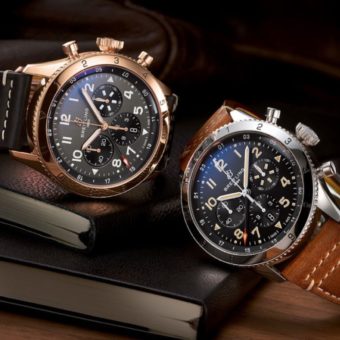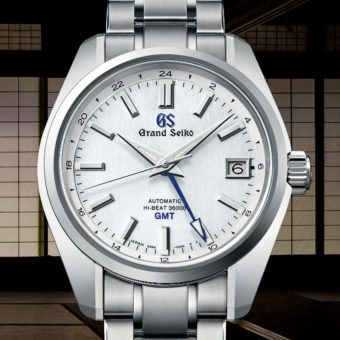WatchTime Los Angeles kicks off this Friday, May 3, with 27 sponsoring watch brands and a host of watch-industry VIPs. Among the brands’ new products on display will be, of course, some new chronograph models making their U.S. debut after being introduced at Baselworld or SIHH. Here are seven that are worthy of a closer look.
The Bremont Arrow is an aviator-style chronograph hailing from Bremont’s new Armed Forces Collection, a trilogy of new models developed in partnership with the British Ministry of Defence that take their inspiration from the famous “Dirty Dozen,” a series of watches commissioned by the British Army during World War II. Housed in a two-part 42-mm case made of hardened steel and powered by the chronometer-rated, automatic BE-51AE movement, the watch features a chronograph operated by a monopusher at 2 o’clock, with readouts indicated by a central red-arrow-tipped chronograph seconds hand, and subdials at 3 o’clock and 9 o’clock for 30 elapsed chronograph minutes and for running seconds, respectively. The matte black dial, which also has a date window at 6 o’clock, has mint-colored Super-LumiNova details. The caseback, like those of all the Armed Forces models, bears the heraldic badges of all three of Britain’s military services, the Army, Royal Navy, and Royal Air Force (RAF); the watch’s strap is in RAF-style blue sailcloth.
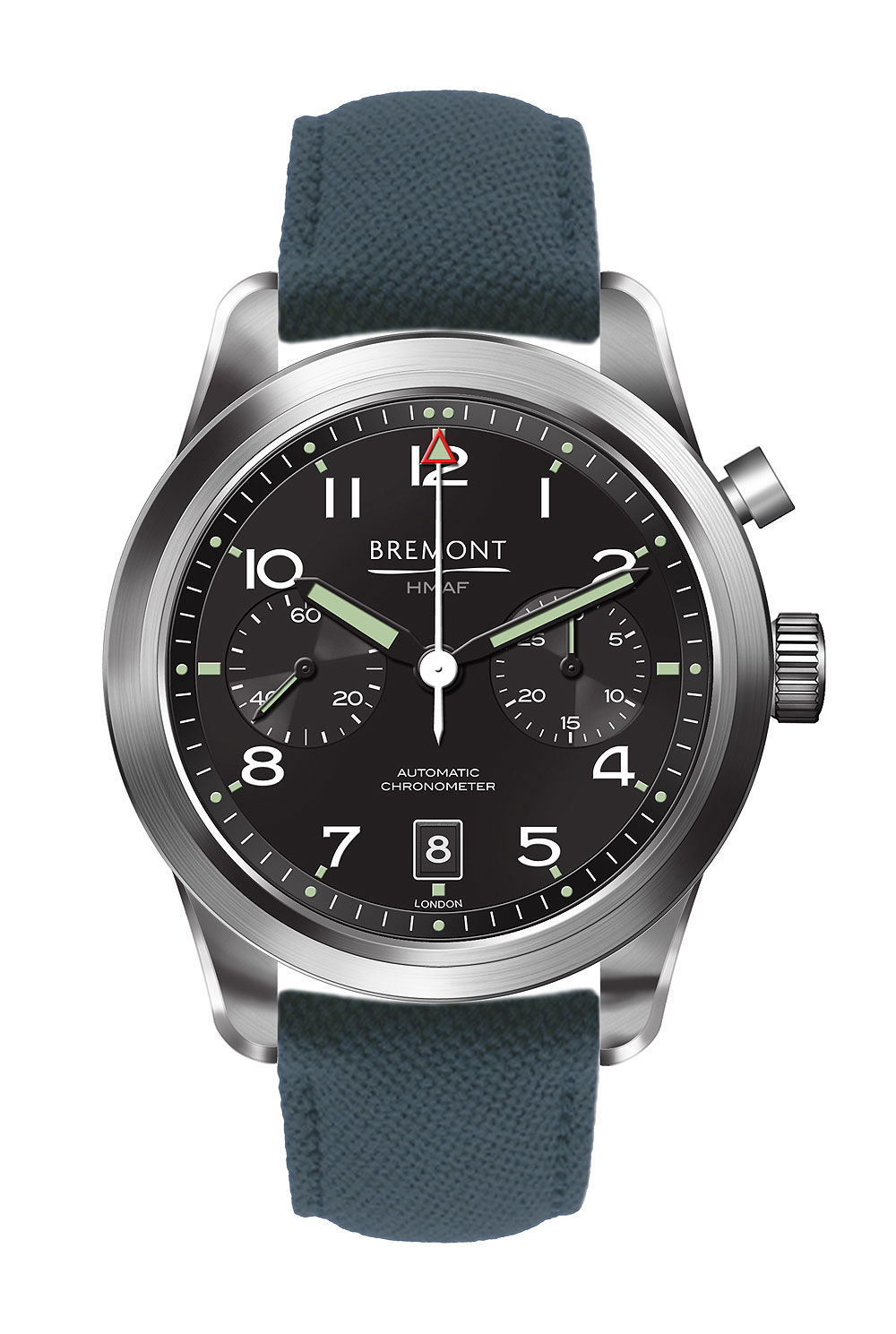
Chronoswiss’s navy-dialed Sirius Chronograph Moon Phase combines a stopwatch with a moon-phase and analog date indicator. Its 41-mm steel case is stylized with partially knurled edges, polished and brushed finishing, unusual tipped chronograph pushers, and a large onion crown. It is secured to the wrist with a blue Louisiana alligator strap using long, straight lugs. Surrounding the blue, partially guilloché-decorated dial is an outer analog date window, with a red-tipped crescent-moon indicator hand sweeping over its face, and a chronograph minutes counter with applied Breguet hour markers between the quarter hour positions. The chronograph’s 30-minute counter is at 12 o’clock, the running seconds at 9 o’clock, and the 12-hour chronograph counter at 6 o’clock. At 3 o’clock you’ll find a moon-phase display accented with a zero-to-29.5 scale representing the length of a typical lunar cycle. Lacquered white “Breguet Losange” hands point to the hour and minute, while a simple pointer indicates the chronograph seconds, white raindrop-style hands sweep the chronograph subdials, and a simple pointer tallies the running seconds. The multi-complication ensemble is powered by the automatic Chronoswiss Caliber C.755, which is based on the ETA 7750 and visible through a sapphire caseback.
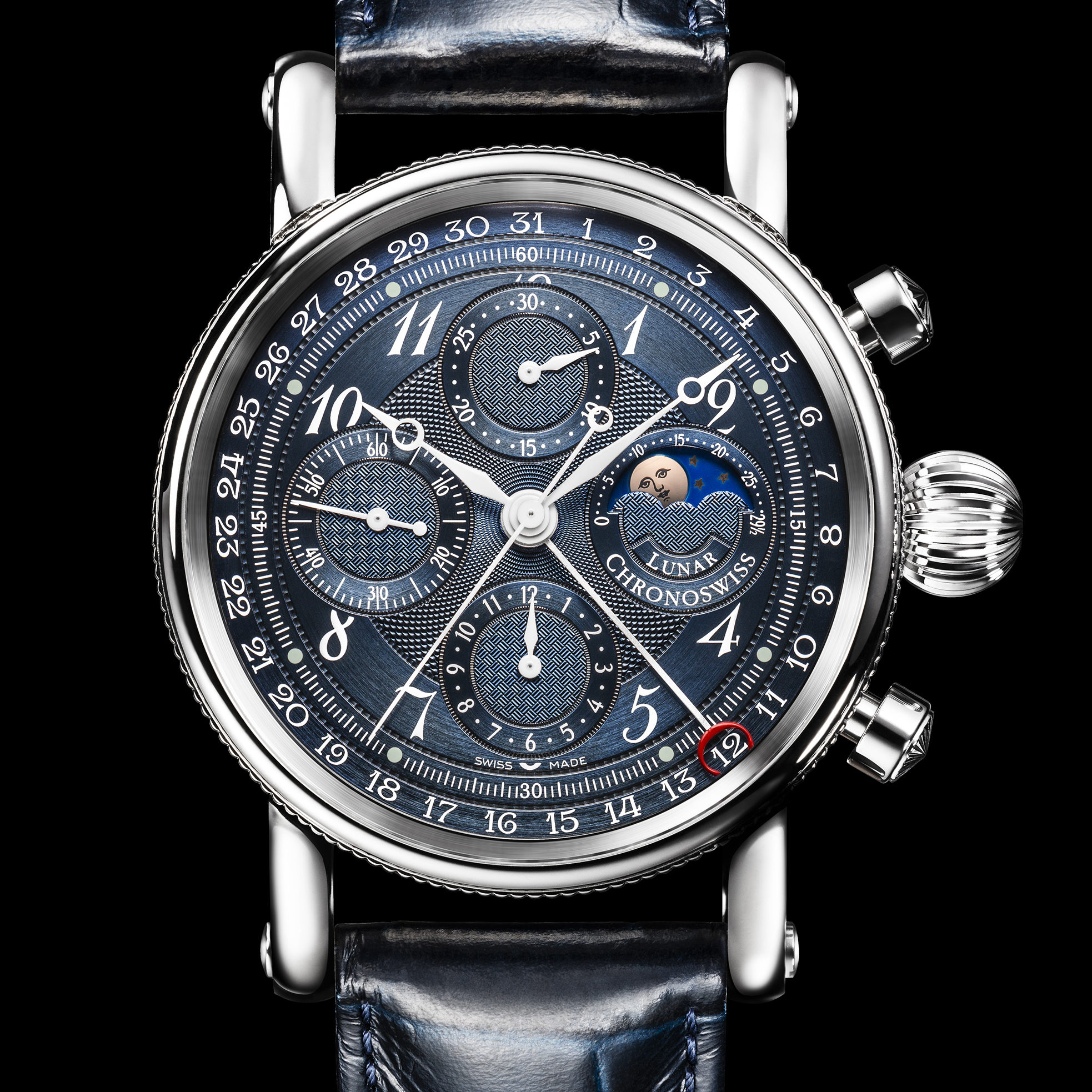
François Czapek was the original partner of Antoine Norbert de Patek (of Patek Philippe) before leaving the nascent brand to form his own watchmaking atelier, Czapek & Cie, in 1845. A Polish immigrant in Geneva, he is credited with opening what is considered the first watch boutique on the Place Vendôme in Paris and served as the official watchmaker to Napoleon III. Today’s Czapek brand, revived in 2015, named its first chronograph, the Faubourg de Cracovie Dioné & Rhea, after the location of one of its namesake’s watch Polish watch boutiques. This year’s new Faubourg de Cracovie Tao is a new take on that watch, with a black-on-white “panda” dial replacing the white-on-black “reverse panda” look of its predecessor. The steel 41.5-mm case has deeply engraved sides and an uncommon integration between its seamless, elongated chronograph pushers and signed crown. On the white grand feu enamel dial are Roman numerals for the hour markers, with a bright red accent to denote 12 o’clock; two contrasting black subdials and a subtle white register indicating the chronograph minutes, hours, and small seconds; and a small date indicator at the 6 o‘clock position. Sweeping over the face are two rhodium-plated “Fleur de Lys” hands and a simple counter for the chronograph seconds. The piece is powered by the automatic Caliber SXH3, with a 65-hour power reserve and a golden rotor visible through a sapphire caseback.
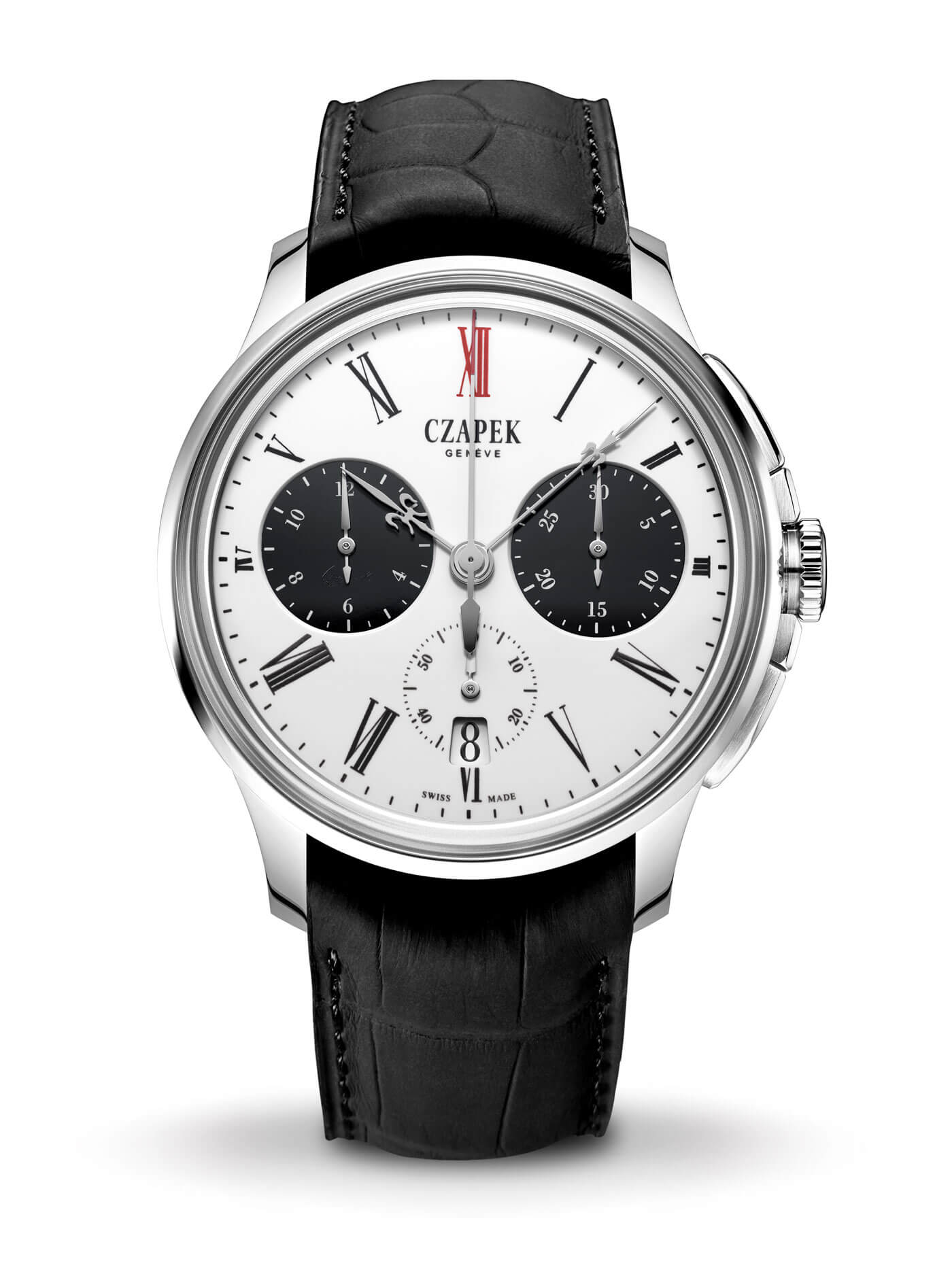
The De Bethune DB21 Maxichrono Réédition is a modern re-issue of the independent brand’s first chronograph, originally released in 2006. The 2019 version is a limited edition of only 10 pieces. The original Maxichrono was notable for its avant-garde design — with five centrally-located hands (two for hours and minutes; three for chronographic functions) and a distinct lack of subdials. This minimalist construction requires an extremely complex movement, with several interdependent column wheels embedded into one another yet still needing to operate independently. In the Maxichrono, each can be zero-reset on demand and can autonomously restart through the use of a single pusher located at 6 o’clock. The benefit of this pared-down design not only increases legibility at a glance but also offers the ability to measure longer times, up to 24 hours in a row, rather than the more common limits of 9 or 12 hours, with 1/10th of a second accuracy. Inside the new Maxichrono is the DB2030 manufacture caliber, fitted with the De Bethune Absolute Clutch and boasting a five-day power reserve.

Grand Seiko is celebrating the 20th anniversary of its Spring Drive movement this year with, among other new models, a new rose-gold-cased version of the Spring Drive Chronograph GMT 9R96 (ref. SBGC230). The 44.5-mm case has a faceted design, specially finished with the brand’s Zaratsu-style polishing, with two prominent chronograph pushers and a LumiBrite-accented black GMT bezel. Beneath the dual-curved sapphire glass is a deep red dial, matching the color of the crocodile leather strap. It has a racing-style racing minute track on the flange, along with large, applied indices, a 3 o’clock date window, a power reserve indicator, and three sub-dials for running seconds, 30 chronograph minutes, and 12 chronograph hours. Passing over the dial are two diamond-cut hands typical of the Grand Seiko Sports line and a simple pointer for the chronograph seconds. Powering the watch is the automatic Spring Drive Caliber 9R96, capable of a 72-hour power reserve and accurate to +/- 0.5 seconds per day, whose gold lion-embossed rotor is on display through a clear sapphire case back. For more detail on how Seiko’s Spring Drive system works, click here.
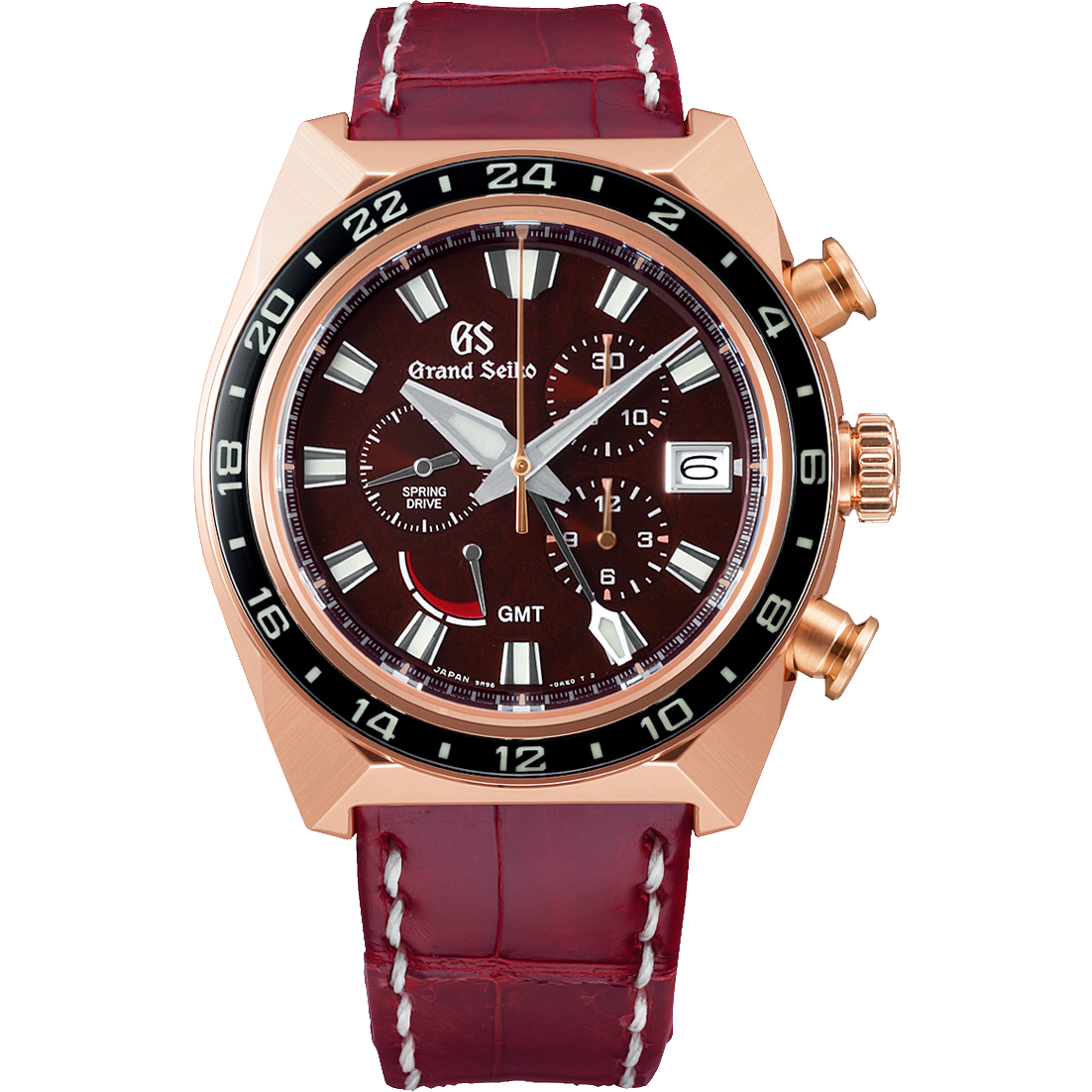
The Montblanc Heritage Pulsograph Limited Edition features a specially designed chronograph complication that was once used by doctors to measure a patient’s resting heart rate. The stainless-steel case measures 40 mm in diameter and contains the Montblanc Manufacture monopusher chronograph Caliber MB M13.21, which is visible through an exhibition caseback. The slightly domed dial features an attractive salmon color and has several design elements that call back to Minerva timepieces from the 1940s and ’50s (Minerva being the legendary chronograph producer that became part of Montblanc after it was acquired by parent company Richemont on 2006). The dial has two different finishes; anthracite applied Arabic numerals and dots for indexes; dauphine hour and minute hands treated with Super-LumiNova; and blued baton hands for the chronograph registers. Another notable retro-style detail: old-school payphone indications at the 3-, 6-, and 9-minute marks on the chronograph’s minute counter that would let payphone users know when to add a coin for more time. Limited to 100 pieces, the watch comes on a color-coordinated, anthracite-colored Sfumato alligator leather strap.
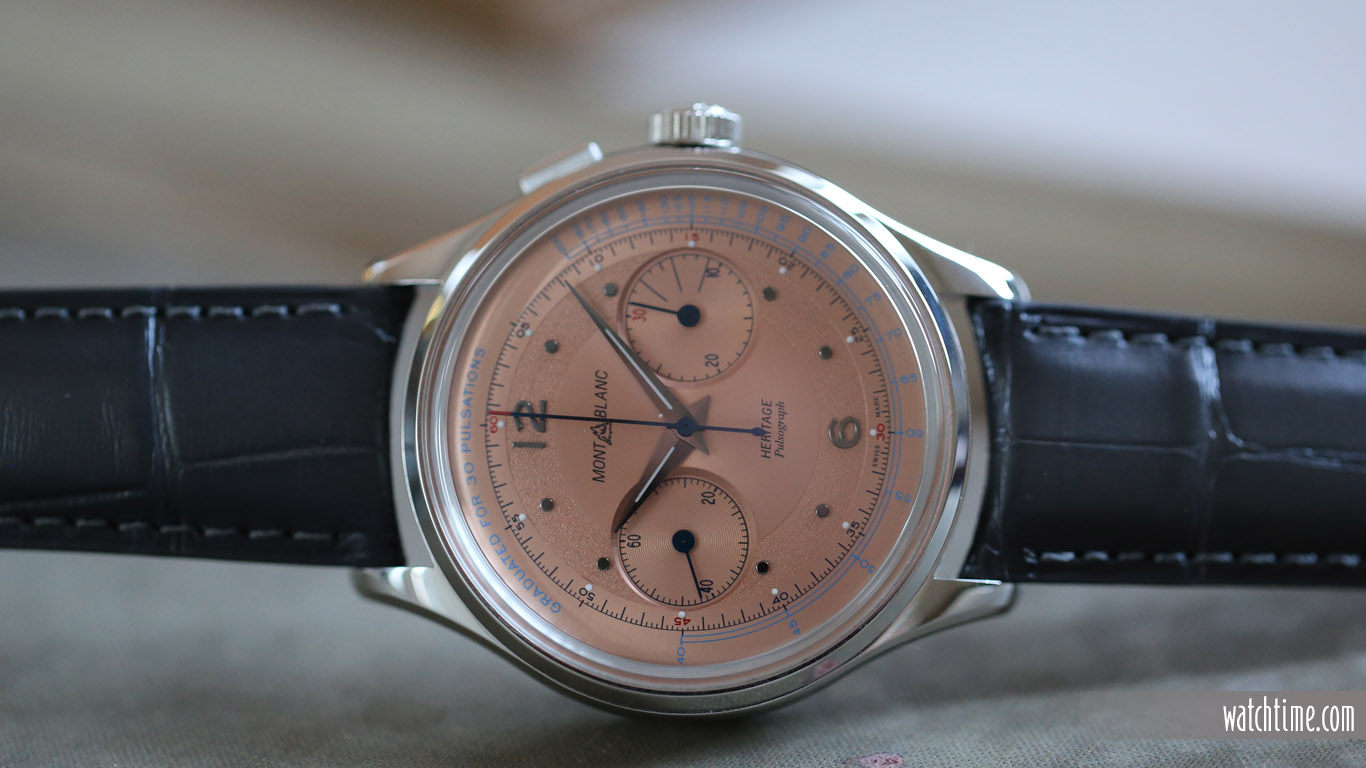
The Zenith El Primero A386 Revival is, as its name implies, a faithful re-creation of the original El Primero watch from 1969, which famously featured the first self-winding chronograph movement to offer a high balance frequency of 36,000 vph, meaning times could be measured to the nearest 1/10 second, along with both an integrated column-wheel construction and a then-unprecedented 50-hour power reserve. The stainless steel case measures a now-modest 38 mm, the same size as the original’s, with a curved, magnifying sapphire crystal. The vintage-look dial offers the same tricolored subdials (light gray for running seconds, blue for elapsed minutes, anthracite for elapsed hours), tachymeter scale, hand shapes and hour markers as the original. The lugs and mushroom-style chrono pushers are also direct descendants of the vintage model’s. Only the caseback, which features a sapphire viewing window while its predecessor was solid, is a nod to modern tastes, and the movement visible through that window is the most up-to-date, contemporary version, the El Primero Caliber 400, with the same 36,600-vph frequency and 50-hour minimum power reserve that wowed the watch community a half-century ago.

There are still tickets available for WatchTime Los Angeles, taking place on May 3-4 at Downtown L.A.’s Hudson Loft. Click here for more info and tickets!




